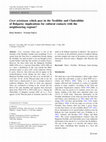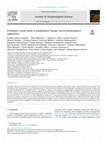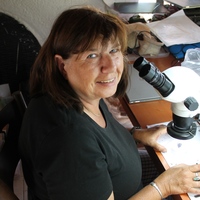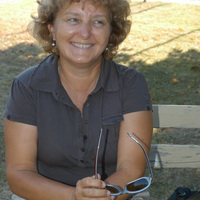Papers by Tzvetana Popova

The use of plants in variety of rituals is common practice in the Antiquity. Numerous archaeobota... more The use of plants in variety of rituals is common practice in the Antiquity. Numerous archaeobotanical remains from different archeological sites presented evidences that some plants were particularly introduced to the religious rituals. The goal of the present study is to identify specific plants and food that was subject of ritual practices. The paper will discuss similarities and differences between different plant remains in the archaeological contexts and will identify which plants were in use as a ritual food. The study is based on a comparative archaeobotanical analysis of several Bronze Age-Iron Age sanctuaries in the therritory of Bulgaria and gives a clear indication of certain similarities and differences between the different regions, which will be discussed as well. The current paper attempts to summarize and make a synthesis of archaeobotanical data, provided from 12 sanctuaries. On the basis of the evidence currently available, there are several main differences in re...
This study discusses the results of archaeobotanical studies carried out in Bulgaria over the las... more This study discusses the results of archaeobotanical studies carried out in Bulgaria over the last five years, with a special focus on the archaeobotanical finds from 36 prehistoric sites from the Neolithic to the Bronze Age. The discussion highlights the great diversity of both cultivated and wild growing and weed plants in the region and provide eveidence for the availability of Mediterannean plants such as cultivated vines, and thus of cultural contacts.

Tzvetana Popovaa, 2022
This paper presents new data on the appearance of the olive in the territory of Bulgaria, based o... more This paper presents new data on the appearance of the olive in the territory of Bulgaria, based on archaeobotanical studies.To date, evidence for the presence of olive findings is still limited and unpublished. This paper will focus on results of olive remains found in 9 archaeological sites in the territory of Bulgaria.The results from the archaeobotanical analysis show that these findings belong to the cultivated form Olea europaea subsp. europaea. The earliest remains from the territory of Bulgaria date back between the 5 th and 3 rd century BCE. During this period olives were not only consumed, but were also transformed into olive oil and other derivative products and this was traded. So far, the presence of olives in the territory of Bulgaria has been very poorly recorded.The material resulting from the ritual hearths in the cemetery at Sozopol (Apollonia Pontica) provides important information about some of the practices of funerary rites associated with the use of plants. In the light of this paucity, the archaeobotanical evidence from these 9 archaeological sites is of particular interest. It is obvious that in the 3 rd century BCE olives were imported together with other species such as stone pine nuts, figs, etc. Its presence shows contacts with the Mediterranean region.The information obtained sheds light on the of significance of Olea europaea subsp. europaea, not only as a nutritional resource, but also as an important component in ritual practices.

VARHARI AND ORLITSA: TWO CHALCOLITHIC SETTLEMENTS IN THE EASTERN RHODOPE MOUNTAINS.ХІІІ. АРХЕОБОТАНИЧЕН АНАЛИЗ НА РАСТИТЕЛНИТЕ ОСТАНКИ, 2022
ARCHAEOBOTANICAL ANALYSIS
OF THE PLANT REMAINS
Tzvetana Popova
The archaeobotanical samples were ... more ARCHAEOBOTANICAL ANALYSIS
OF THE PLANT REMAINS
Tzvetana Popova
The archaeobotanical samples were collected during several consecutive archaeological
seasons. The samples comprise charred plant remains, such as seeds, grains of cereals and
weeds, as well as charred wood. Most of the plant remains were found in dug-in features,
which were parts of the residential complexes. It has to be pointed out that the discovered
remains comprise huge numbers of various domesticated plants, which in most cases were
stored as supplies.
The following contexts were studied: dug-in features №№ 6, 7, 8, 11, 17, 21 and 24,
30, 33A, 33B, 34B, 36 as well as samples collected from squares F44, G44, M28, M29, T16,
V13 and Q27.
The information from Varhari allows to define two main types of cultivated plants:Bitter vetch (Vicia ervilia) and еinkorn wheat (Triticum monococcum). There are imprints of еinkorn wheat, barley, wild cereals and probably bromes (Bromus) on fragments of clay plaster. The fact that the White goosefoot (Chenopodium album) seeds were found with
other food supplies and were not mixed with vetch suggests that the plant was used for human consumption.
The Bitter vetch was the favourite food despite the toxins in the seeds; however, it had to be soaked in water before consumption. On the other hand, the plant can be grown in dry conditions, and this was clearly an advantage compared to other legumes.

Ivan Vajsov, Vladimir Slavchev, Gabriela Dzhurkovska, Galya Vandeva, Tzvetana Popova, Nadezhda Karastoyanova. 2021. No. 17. The 2020 Season of the Research Excavations on Golemija ostrov Tell Near Durankulak. – Archaeological Discoveries and Exavations 2020, Book 1, Sofia 2021, 246—251, 2021
The results of the study of building № 25 / VII-VIII showed that it has a slightly trapezoidal sh... more The results of the study of building № 25 / VII-VIII showed that it has a slightly trapezoidal shape. The total built-up area is 69 m2. The building has undergone two stages of development: the first stage refers to the Hamangia III Culture, and the second one - to Hamangia IV Culture.
The building from sub-stage 1A was small, of a shape close to the square measuring 6.5 × 6.0 m. Internal dimensions are 5.5 × 4.0 m (22 m²). Its massive walls have double-sided stone foundations 0.50 – 0.60 m wide. A thermal structure was attached to the eastern wall – a hearth with a half-dome; and to the western one – a clay podium with a square shape measuring 1.50 × 1.50 m and a height of 10 cm. There were several small and large clay structures of unclear shapes and purposes next to the northern wall. The structures in the room occupied about 15% of the living space.
In stage 1B, an annex was added to the building from the south, probably a covered terrace. For this purpose, the eastern and western walls were elongated by 5 m each. The dimensions of this extension are 4.5 × 5.5 m (20 m²). It rose 15 – 20 cm above the room from stage 1A, and the approach to the inner room was stepped. Several additional economic segments were situated there: a domed oven located in its south-eastern corner and an elongated clay trough (?) – in the south-western one.
During stage 2 the interior of the building was completely changed. A large room with dimensions of 10.0 × 4.5 m (45 m²) was formed. The building from this stage was open from the south where a wooden colonnade was arranged. This porch was covered with a stone pavement.
The life of building № 25 / VII ended with a fire, followed by a strong destructive earthquake, around the IX degree after MSK-64. It also marks the end of the settlement from the period of Hamangia IV Culture.
In 2020, the research of building № 24 / VII continued as well. There we came across the northwestern part of an unexplored earlier building – № 23 / V. The remains are framed by a low clay plinth 5 – 6 cm high. On the floor of the structure we found a charred grain of Triticum monococcum and Triticum dicoccum with an approximate ratio of 50:50%.

Cicer arietinum (chick pea), is one of the elements of the Neolithic founder crop assemblage. It ... more Cicer arietinum (chick pea), is one of the elements of the Neolithic founder crop assemblage. It was spread from the Near East to southeastern Europe during the Neolithic, but until recently it was not thought to have reached further north than the territory of modern Greece. However, the latest finds from the Bulgarian Neolithic (6000-5450 cal B.C.) and late Chalcolithic (4450-3900 cal B.C.) show a distribution of this crop outside the Mediterranean region, to areas with a more temperate climate. It seems, however, that chick pea did not appear in the archaeobotanical record during the first stages of the Bulgarian Neolithic period, but only in its second half, or even later. So far, on the Thracian plain only at one site which from a cultural point of view is strongly related to southwest Bulgaria, have finds of chick pea appeared. These are considered to belong to the second and last third of the early Neolithic and originate from structures dated from 5920-5730 to 5670-5450 cal ...

The use of plants in variety of rituals is common practice in the Antiquity. Numerous archaeobota... more The use of plants in variety of rituals is common practice in the Antiquity. Numerous archaeobotanical remains from different archeological sites presented evidences that some plants were particularly introduced to the religious rituals. The goal of the present study is to identify specific plants and food that was subject of ritual practices. The paper will discuss similarities and differences between different plant remains in the archaeological contexts and will identify which plants were in use as a ritual food. The study is based on a comparative archaeobotanical analysis of several Bronze Age –Iron Age sanctuaries in the therritory of Bulgaria and gives a clear indication of certain similarities and differences between the different regions, which will be discussed as well. The current paper attempts to summarize and make a synthesis of archaeobotanical data, provided from 12 sanctuaries. On the basis of the evidence currently available, there are several main differences in r...

Fonde sur les rives meridionales de la lagune de Goloviţa, l’etablissement grec d’Acic Suat se de... more Fonde sur les rives meridionales de la lagune de Goloviţa, l’etablissement grec d’Acic Suat se developpe des le second quart du VIe s. av. J.-C. sur une peninsule disposee a l’entree du golfe de Baia. Distinct des vestiges identifies au XIXe s. par K. F. Peters, ce site peut correspondre, par sa chronologie et sa localisation, a celui designe sous le nom de « Caraburun » dans les etudes consacrees au territoire d’Istros. Depuis 2011, la mission archeologique franco-roumaine a Orgame a deploye autour de cet etablissement un programme de recherche pluridisciplinaire qui permet desormais d’en esquisser la trajectoire historique, tout comme les contours. L’objet de cet article n’est pas tant de detailler l’ensemble des resultats obtenus que de presenter la methodologie employee, laquelle offre une approche globale sur cette communaute coloniale installee a mi-chemin entre Orgame et Istros

InterdIscIplInary studIes, 2019
The article presents activities and data obtained during the first year of the project. The resea... more The article presents activities and data obtained during the first year of the project. The research area encompasses Southeastern Bulgaria with nine main sites included. Object of instrumental research and archeological characteristic are the samples, which are divided into the following groups: denudated rocks, and used for inorganic temper; clays – tectonic and alluvial; ceramics- pottery fragments and burnt remains of stationary equipment; organic fillers, pigments and substances for painting and incrustation, organic residues and impressions of mats and baskets on the pottery bases. . Different methods and analyzes have been applied to solve the problems posed: cartographic analysis and description of the landscape, morphological and typological analysis, dating, instrumental methods, chemical analysis, scanning electron microscopy (SEM ), petrographic analysis etc.

Plants and Environment: Archaeobotanical research of Bronze Age settlements in Upper Thrace: tell Himitliyata and tell Galabovo , 2021
Abstract
Within the archaeological research, archaeobotanical analyses have a well-established r... more Abstract
Within the archaeological research, archaeobotanical analyses have a well-established role in providing information on both natural and archaeological environments. Plant choice and diversity are defined mainly by the environmental constraints and in the second place, by cultural and economic factors. Macroscopic plant remains found at tell Galabovo and tell Himitliyata represent both cultivated and wild plant taxa. The remains of cultivated plants confirmed that plant resources formed an important part of the past subsistence strategies. During the EBA, barley (Hordeum vulgare L.), four types of wheat (Triticum sp.) and legumes, such as lentil (Lens culinaris Medik.) and bitter vetch (Vicia ervilia L.), were the dominant crops. A consistent choice of varied cereal species, along with pulses, may indicate that both winter and summer crops were cultivated and activities dedicated to crop farming were distributed along different periods of the year. Nuts and fruits were an inseparable part of the main food supply. Altogether, macroscopic plant remains are related mainly to synanthropic habitats from fields to ruderal ones. The remains of wood preserved as charcoal represent a separate group of plants and may be used for the reconstruction of local woodlands.
Figure 16 : Monnaie en bronze d' Alexandre KEF-1547 (Mission de Kition, C. Hadjivasili). Sabine F... more Figure 16 : Monnaie en bronze d' Alexandre KEF-1547 (Mission de Kition, C. Hadjivasili). Sabine Fourrier -Université Lumière-Lyon 2 -UMR 5189, HISOMA Alexandre Rabot -Université Lumière-Lyon 2 -UMR 5189, HISOMA La Mission archéologique franco-bulgare à Apollonia du Pont (Sozopol, Bulgarie) : le tumulus aristocratique de la parcelle cadastrale UPI 7547 (iv e siècle avant J.-C.)
Setting the Bronze Age Table: Archaeobotanical Evidence of Subsistence Economy at the Early Bronze Age Settlement Near Sokol, Bulgaria, 2021
Settlement mound “Himitliyata” is located in Upper Thrace, Southeastern Bulgaria. The available p... more Settlement mound “Himitliyata” is located in Upper Thrace, Southeastern Bulgaria. The available paleobotanical data indicate that during the Early Bronze Age local environmental conditions were favorable
and probably had an impact on subsistence strategies. A reconstruction of these strategies is proposed mainly
on the basis of archaeological evidence and archaeobotanical remains recovered from recent excavations at
the site. The archaeobotanical assemblage is comprised of annual cereal crops and legumes. Several common
ruderal species, widespread in the crop fields, represent the probable agricultural practices during the Early
Bronze Age.

Arhaica 6, 2018
In prehistoric times, humans combined a variety of food provision strategies and in order to ensu... more In prehistoric times, humans combined a variety of food provision strategies and in order to ensure a balanced diet. These strategies largely depended upon locally available natural resources. Even after animal husbandry and agriculture emerged, strategies such as wild plant gathering and hunting remained reliable methods of food procurement. The information about gathering of wild edible plants in prehistoric times in Bulgaria derives from the finds of wild plant seeds and fruit stones in archaeobotanical samples. The archaeobotanical data on wild plants and fruits show a regular presence of Cornelian cherry tree, grapes, walnut, hazelnuts, acorns, and seeds from different shrubby plants and herbs. The evidence clearly demonstrates that, during the Neolithic and Chalcolithic times in the territory of Bulgaria, agricultural societies made use of different resources to ensure regular and diverse food supplies.

Prehistoric cereal foods of southeastern Europe: An archaeobotanical exploration, 2019
This paper addresses for the first time a large body of archaeobotanical data from prehistoric So... more This paper addresses for the first time a large body of archaeobotanical data from prehistoric Southeastern Europe, mostly published for the first time, that correspond to cereal food preparations. The evidence presented here comes from 20 sites situated in Greece and Bulgaria, spanning the Early Neolithic through to the Iron Age (7th millennium B.C.-1st millennium B.C.). The remains correspond to cereal fragments or agglomerations of fragments that resulted from ancient food preparation steps such as grinding, boiling, sprouting/malting, mixing in bread-like or porridge-like foodstuffs. The article builds on previous pilot studies and with the aid of stereomicroscopy and scanning electron microscopy offers a first classification and possible interpretations of the finds leading to the recipes that might have generated them. At the same time the article highlights the significance of retrieving and studying in depth such rare archaeobotanical finds, points out the interpretative problems stemming from such material and suggests ways forward to address similar archaeological finds in different parts of the world. The paper demonstrates the potential of the systematic study of cereal-based food remains, in our case prehistoric Southeastern Europe, to reveal a wide variability in cereal food transformation practices, suggestive of the interplay between available ingredients, cultural traditions and the complex interaction between society and environment.
RAC/TRAC, 2018 Edinburg, 2018
Tzvetana Popova, Hanna Hristova
During the Roman period a few typical Mediterranean plants becam... more Tzvetana Popova, Hanna Hristova
During the Roman period a few typical Mediterranean plants became part of the common diet in almost every part of the Empire. Though, the distribution of this species varies substantially. The different meanings that accumulate around objects or food within a particular culture have implications for their use, including their potential for distribution. The finds from the territory of Bulgaria indicate common tendencies that present a special treatment of imported plants, used in different rituals, honoring the deceased or deities. In the periphery of the empire they were likely to be imported in small quantities as a privilege of the wealthier. All of the reviewed archaeobotanical data found on the territory of Bulgaria comes from well-developed centers with certain Mediterranean influence.
Palaeconomics and the environment in the region of the town of Septemvri - Pistiros and its neighborhoods., 2018
The archaeological site Pistiros is localized on the shore of an alluvial ledge in the countrysid... more The archaeological site Pistiros is localized on the shore of an alluvial ledge in the countryside “Adjiyjska vodenitsa (mill)”, on the left bank of Maritsa River. A large commercial centre was found there - Emporium Pistiros, founded by traders from the island of Thasos. The contacts with the Greek cities were intense (Chiverrell, Archibald, 2009).
According to archaeological data, Pistiros was founded during the time of the first kings of the Odrysian state - Teres and Sitalces. At the time of Amatokos I the emporium maintains very close links with the neighbouring countries.
The user has requested enhancement of the downloaded file.

AbSTRACT The use of plants in variety of rituals is common practice in the Antiquity. Numerous ar... more AbSTRACT The use of plants in variety of rituals is common practice in the Antiquity. Numerous archaeobotanical remains from different archeological sites presented evidences that some plants were particularly introduced to the religious rituals. The goal of the present study is to identify specific plants and food that was subject of ritual practices. The paper will discuss similarities and differences between different plant remains in the archaeological contexts and will identify which plants were in use as a ritual food. The study is based on a comparative archaeobotanical analysis of several Bronze Age –Iron Age sanctuaries in the therritory of Bulgaria and gives a clear indication of certain similarities and differences between the different regions, which will be discussed as well. The current paper attempts to summarize and make a synthesis of archaeobotanical data, provided from 12 sanctuaries. On the basis of the evidence currently available, there are several main differences in regard to the cultivated plants that are established. The recorded variety of plant species used in ritual context – cereals, pulses, fruits, etc., mainly depends on the location of the sacred place and the ecological characteristics of the region. In pit sanctuaries einkorn was more frequently used in rituals, as in mountaintop and rock sanctuaries free threshing wheat is dominant along with barley and millet that also occur in the studied samples. Barley is also recorded in archaeobotanical material, collected at the site of Nessebar " Kindergarten " / site " Detska gradina " , Kabyle and Krepost. Presence of millet in some Late Iron Age sites like Koprivlen and Svilengrad, indicates that it was among the cultivated cereals in the region and was used even in ritual practices. Although most of the botanical remains found in sanctuaries are quite common, they evidence diversity in characteristics of the floristic assemblages. Analyzed material includes numerous findings of four types of wheat: einkorn, emmer, spelt wheat and free threshing wheat. Millet, naked and hulled barley, rye, oat also occur, along with some Leguminous plants presented by: pea, lentil, bitter vetch, chickpea and grass pea (Lathyrus sativus). A wide range of fruits and nuts that grow wild in the vicinity of forest habitats is also represented – such as wild grape, blueberry, raspberry, wild cherry, plums, acorn, walnut, etc. A matter of interest are the plant remains from jujube (Zizyphus vulgaris), pink rockrose (Cistus incanus), European nettle tree or the so called Mediterranean hackberry (Celtis australis), that were recorded for the first time and were probably used with purpose in ritual practices. Some of the studied archaeological structures can be interpreted as special sacred places, while other, according to the analyzed material, cannot be defined with certainty. That means plant remains in these contexts may be used as offerings, other could be part of food storage.








Uploads
Papers by Tzvetana Popova
OF THE PLANT REMAINS
Tzvetana Popova
The archaeobotanical samples were collected during several consecutive archaeological
seasons. The samples comprise charred plant remains, such as seeds, grains of cereals and
weeds, as well as charred wood. Most of the plant remains were found in dug-in features,
which were parts of the residential complexes. It has to be pointed out that the discovered
remains comprise huge numbers of various domesticated plants, which in most cases were
stored as supplies.
The following contexts were studied: dug-in features №№ 6, 7, 8, 11, 17, 21 and 24,
30, 33A, 33B, 34B, 36 as well as samples collected from squares F44, G44, M28, M29, T16,
V13 and Q27.
The information from Varhari allows to define two main types of cultivated plants:Bitter vetch (Vicia ervilia) and еinkorn wheat (Triticum monococcum). There are imprints of еinkorn wheat, barley, wild cereals and probably bromes (Bromus) on fragments of clay plaster. The fact that the White goosefoot (Chenopodium album) seeds were found with
other food supplies and were not mixed with vetch suggests that the plant was used for human consumption.
The Bitter vetch was the favourite food despite the toxins in the seeds; however, it had to be soaked in water before consumption. On the other hand, the plant can be grown in dry conditions, and this was clearly an advantage compared to other legumes.
The building from sub-stage 1A was small, of a shape close to the square measuring 6.5 × 6.0 m. Internal dimensions are 5.5 × 4.0 m (22 m²). Its massive walls have double-sided stone foundations 0.50 – 0.60 m wide. A thermal structure was attached to the eastern wall – a hearth with a half-dome; and to the western one – a clay podium with a square shape measuring 1.50 × 1.50 m and a height of 10 cm. There were several small and large clay structures of unclear shapes and purposes next to the northern wall. The structures in the room occupied about 15% of the living space.
In stage 1B, an annex was added to the building from the south, probably a covered terrace. For this purpose, the eastern and western walls were elongated by 5 m each. The dimensions of this extension are 4.5 × 5.5 m (20 m²). It rose 15 – 20 cm above the room from stage 1A, and the approach to the inner room was stepped. Several additional economic segments were situated there: a domed oven located in its south-eastern corner and an elongated clay trough (?) – in the south-western one.
During stage 2 the interior of the building was completely changed. A large room with dimensions of 10.0 × 4.5 m (45 m²) was formed. The building from this stage was open from the south where a wooden colonnade was arranged. This porch was covered with a stone pavement.
The life of building № 25 / VII ended with a fire, followed by a strong destructive earthquake, around the IX degree after MSK-64. It also marks the end of the settlement from the period of Hamangia IV Culture.
In 2020, the research of building № 24 / VII continued as well. There we came across the northwestern part of an unexplored earlier building – № 23 / V. The remains are framed by a low clay plinth 5 – 6 cm high. On the floor of the structure we found a charred grain of Triticum monococcum and Triticum dicoccum with an approximate ratio of 50:50%.
Within the archaeological research, archaeobotanical analyses have a well-established role in providing information on both natural and archaeological environments. Plant choice and diversity are defined mainly by the environmental constraints and in the second place, by cultural and economic factors. Macroscopic plant remains found at tell Galabovo and tell Himitliyata represent both cultivated and wild plant taxa. The remains of cultivated plants confirmed that plant resources formed an important part of the past subsistence strategies. During the EBA, barley (Hordeum vulgare L.), four types of wheat (Triticum sp.) and legumes, such as lentil (Lens culinaris Medik.) and bitter vetch (Vicia ervilia L.), were the dominant crops. A consistent choice of varied cereal species, along with pulses, may indicate that both winter and summer crops were cultivated and activities dedicated to crop farming were distributed along different periods of the year. Nuts and fruits were an inseparable part of the main food supply. Altogether, macroscopic plant remains are related mainly to synanthropic habitats from fields to ruderal ones. The remains of wood preserved as charcoal represent a separate group of plants and may be used for the reconstruction of local woodlands.
and probably had an impact on subsistence strategies. A reconstruction of these strategies is proposed mainly
on the basis of archaeological evidence and archaeobotanical remains recovered from recent excavations at
the site. The archaeobotanical assemblage is comprised of annual cereal crops and legumes. Several common
ruderal species, widespread in the crop fields, represent the probable agricultural practices during the Early
Bronze Age.
During the Roman period a few typical Mediterranean plants became part of the common diet in almost every part of the Empire. Though, the distribution of this species varies substantially. The different meanings that accumulate around objects or food within a particular culture have implications for their use, including their potential for distribution. The finds from the territory of Bulgaria indicate common tendencies that present a special treatment of imported plants, used in different rituals, honoring the deceased or deities. In the periphery of the empire they were likely to be imported in small quantities as a privilege of the wealthier. All of the reviewed archaeobotanical data found on the territory of Bulgaria comes from well-developed centers with certain Mediterranean influence.
According to archaeological data, Pistiros was founded during the time of the first kings of the Odrysian state - Teres and Sitalces. At the time of Amatokos I the emporium maintains very close links with the neighbouring countries.
OF THE PLANT REMAINS
Tzvetana Popova
The archaeobotanical samples were collected during several consecutive archaeological
seasons. The samples comprise charred plant remains, such as seeds, grains of cereals and
weeds, as well as charred wood. Most of the plant remains were found in dug-in features,
which were parts of the residential complexes. It has to be pointed out that the discovered
remains comprise huge numbers of various domesticated plants, which in most cases were
stored as supplies.
The following contexts were studied: dug-in features №№ 6, 7, 8, 11, 17, 21 and 24,
30, 33A, 33B, 34B, 36 as well as samples collected from squares F44, G44, M28, M29, T16,
V13 and Q27.
The information from Varhari allows to define two main types of cultivated plants:Bitter vetch (Vicia ervilia) and еinkorn wheat (Triticum monococcum). There are imprints of еinkorn wheat, barley, wild cereals and probably bromes (Bromus) on fragments of clay plaster. The fact that the White goosefoot (Chenopodium album) seeds were found with
other food supplies and were not mixed with vetch suggests that the plant was used for human consumption.
The Bitter vetch was the favourite food despite the toxins in the seeds; however, it had to be soaked in water before consumption. On the other hand, the plant can be grown in dry conditions, and this was clearly an advantage compared to other legumes.
The building from sub-stage 1A was small, of a shape close to the square measuring 6.5 × 6.0 m. Internal dimensions are 5.5 × 4.0 m (22 m²). Its massive walls have double-sided stone foundations 0.50 – 0.60 m wide. A thermal structure was attached to the eastern wall – a hearth with a half-dome; and to the western one – a clay podium with a square shape measuring 1.50 × 1.50 m and a height of 10 cm. There were several small and large clay structures of unclear shapes and purposes next to the northern wall. The structures in the room occupied about 15% of the living space.
In stage 1B, an annex was added to the building from the south, probably a covered terrace. For this purpose, the eastern and western walls were elongated by 5 m each. The dimensions of this extension are 4.5 × 5.5 m (20 m²). It rose 15 – 20 cm above the room from stage 1A, and the approach to the inner room was stepped. Several additional economic segments were situated there: a domed oven located in its south-eastern corner and an elongated clay trough (?) – in the south-western one.
During stage 2 the interior of the building was completely changed. A large room with dimensions of 10.0 × 4.5 m (45 m²) was formed. The building from this stage was open from the south where a wooden colonnade was arranged. This porch was covered with a stone pavement.
The life of building № 25 / VII ended with a fire, followed by a strong destructive earthquake, around the IX degree after MSK-64. It also marks the end of the settlement from the period of Hamangia IV Culture.
In 2020, the research of building № 24 / VII continued as well. There we came across the northwestern part of an unexplored earlier building – № 23 / V. The remains are framed by a low clay plinth 5 – 6 cm high. On the floor of the structure we found a charred grain of Triticum monococcum and Triticum dicoccum with an approximate ratio of 50:50%.
Within the archaeological research, archaeobotanical analyses have a well-established role in providing information on both natural and archaeological environments. Plant choice and diversity are defined mainly by the environmental constraints and in the second place, by cultural and economic factors. Macroscopic plant remains found at tell Galabovo and tell Himitliyata represent both cultivated and wild plant taxa. The remains of cultivated plants confirmed that plant resources formed an important part of the past subsistence strategies. During the EBA, barley (Hordeum vulgare L.), four types of wheat (Triticum sp.) and legumes, such as lentil (Lens culinaris Medik.) and bitter vetch (Vicia ervilia L.), were the dominant crops. A consistent choice of varied cereal species, along with pulses, may indicate that both winter and summer crops were cultivated and activities dedicated to crop farming were distributed along different periods of the year. Nuts and fruits were an inseparable part of the main food supply. Altogether, macroscopic plant remains are related mainly to synanthropic habitats from fields to ruderal ones. The remains of wood preserved as charcoal represent a separate group of plants and may be used for the reconstruction of local woodlands.
and probably had an impact on subsistence strategies. A reconstruction of these strategies is proposed mainly
on the basis of archaeological evidence and archaeobotanical remains recovered from recent excavations at
the site. The archaeobotanical assemblage is comprised of annual cereal crops and legumes. Several common
ruderal species, widespread in the crop fields, represent the probable agricultural practices during the Early
Bronze Age.
During the Roman period a few typical Mediterranean plants became part of the common diet in almost every part of the Empire. Though, the distribution of this species varies substantially. The different meanings that accumulate around objects or food within a particular culture have implications for their use, including their potential for distribution. The finds from the territory of Bulgaria indicate common tendencies that present a special treatment of imported plants, used in different rituals, honoring the deceased or deities. In the periphery of the empire they were likely to be imported in small quantities as a privilege of the wealthier. All of the reviewed archaeobotanical data found on the territory of Bulgaria comes from well-developed centers with certain Mediterranean influence.
According to archaeological data, Pistiros was founded during the time of the first kings of the Odrysian state - Teres and Sitalces. At the time of Amatokos I the emporium maintains very close links with the neighbouring countries.
http://haemus.org.mk
Settlements, Culture and Population Dynamics in Balkan Prehistory
International Conference
13-14.03.2015
Skopje, Republic of Macedonia
ABSTRACTS OF THE ORAL AND POSTER PRESENTATIONS
General Editor: Vasilka Dimitrovska
Cover Design: Vasilka Dimitrovska, Elka Anastasova
Design: Elka Anastasova
Editing and English proofreading: Mark Branov